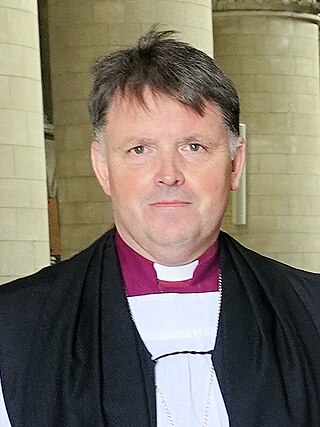Related Research Articles
Æthelnoth was the archbishop of Canterbury from 1020 until his death. Descended from an earlier English king, Æthelnoth became a monk prior to becoming archbishop. While archbishop, he travelled to Rome and brought back saint's relics. He consecrated a number of other bishops who came from outside his archdiocese, leading to some friction with other archbishops. Although he was regarded as a saint after his death, there is little evidence of his veneration or of a cult in Canterbury or elsewhere.
Paulinus was a Roman missionary and the first Bishop of York. A member of the Gregorian mission sent in 601 by Pope Gregory I to Christianize the Anglo-Saxons from their native Anglo-Saxon paganism, Paulinus arrived in England by 604 with the second missionary group. Little is known of Paulinus's activities in the following two decades.
Honorius was a member of the Gregorian mission to Christianize the Anglo-Saxons from their native Anglo-Saxon paganism in 597 AD who later became Archbishop of Canterbury. During his archiepiscopate, he consecrated the first native English bishop of Rochester as well as helping the missionary efforts of Felix among the East Anglians. Honorius was the last to die among the Gregorian missionaries.

William Giffard, was the Lord Chancellor of William II and Henry I, from 1093 to 1101, and Bishop of Winchester (1100–1129).

The Bishop of Norwich is the ordinary of the Church of England Diocese of Norwich in the Province of Canterbury. The diocese covers most of the county of Norfolk and part of Suffolk. The bishop of Norwich is Graham Usher.
Philip Repyngdon was a bishop and cardinal.
Romanus was the second bishop of Rochester and presumably was a member of the Gregorian mission sent to Kent to Christianize the Anglo-Saxons from their native Anglo-Saxon paganism. Romanus was consecrated bishop around 624 and died before 627 by drowning. Little is known of his life beyond these facts.
Walter Haselshaw was a medieval English Bishop of Bath and Wells. He was elected 7 August 1302 and consecrated 4 November 1302. He died 11 December 1308.
Richard Clifford was a Bishop of London who had previously been Bishop of Worcester, Bishop-elect of Bath and Wells, and Lord Privy Seal.
Simon Sydenham was a medieval Dean of Salisbury and Bishop of Chichester.
Trumhere was a medieval Bishop of Mercia.
Headda was a medieval Bishop of Lichfield.
Ealdwulf was a medieval Bishop of Lichfield.
Wine was a medieval Bishop of London, having earlier been consecrated the first Bishop of Winchester.
Richard Newport was a medieval Bishop of London.
Thomas Hemenhale was a medieval Bishop of Norwich-elect and then Bishop of Worcester.
Aldwulf or Ealdwulf was a medieval Bishop of Rochester. He was probably consecrated in 727 and died in 739. According to Bede his consecrator was Archbishop Berctwald.
Wigberht was a medieval Bishop of Sherborne.
Leuthere was an Anglo-Saxon Bishop of Winchester.
Ælfsige was a medieval Bishop of Winchester. He was consecrated between 1012 and 1013. He died in 1032. In his will, he named Ealdorman Ælfheah as the guardian of his relatives and his last testament, as well as an estate at Crondall.
References
- ↑ Fryde, E. B.; Greenway, D. E.; Porter, S.; Roy, I. (1986). Handbook of British Chronology (3rd ed.). Cambridge: Cambridge University Press. p. 216. ISBN 0-521-56350-X.
- ↑ Kirby, D. P. (2000). The Earliest English Kings. New York: Routledge. p. 66. ISBN 0-415-24211-8.